Peter MALONE
Praying at home during this Coronavirus Holy Week
Praying at home during this Coronavirus Holy Week.
A theologian offers a practical way for Catholics to celebrate the most important liturgical events of the Christian faith
Thomas O’Loughlin United Kingdom, La Croix April 3, 2020 - from Claude Mostowik MSC , Justice and Peace.
You can divide religions into two categories: those most at home in a large public space and those most at home in the domestic space.
Most contemporary Christians, at least in the West, know only the former. They own many big buildings – and that is where religion takes place.
If it takes place elsewhere, that is really just "a follow up". Christians seem to like big public statements.
But it is startling to recall that the original Eucharistic meals – where the followers of Jesus distinguished themselves from their fellow Jews – took place in their homes.
"Day by day, as they spent much time together in the temple, they broke the loaf at home and ate their food with glad and generous hearts" (Acts 2, 46).
In this domestic setting, they were in tune with their Jewish roots.
Every meal was to be an occasion at which those gathered blessed God (Dt 8, 10); the weekly meal with which the Sabbath began was a special act of praise, and the most special night of the year is the Passover meal when God's liberating deeds are recalled around the table.
This year – in most places – Christians are going to have to rediscover this domestic liturgical space.
Let us remind ourselves of some basics.
- Jesus is present with us
The risen Jesus is present in every community, however small. This was captured in a saying that's preserved in Matthew's gospel: "For where two or three are gathered in my name, I am there among them" (Mt 18, 20).
Even the smallest gathering – just two people staying two meters apart so as not to spread the virus – has the Risen Lord is among them.
This might be two people in a house, or it might be people linked on the phone or on Skype.
This was expressed in another ancient Christian saying – preserved in the Didache (a first-century new disciples' guide): "Wherever the things of the Lord are spoken about, there the Lord is present" (4:1).
- Our sitting room is a place of prayer
We might be feeling the lack of a church building, but recall this instruction by Jesus:
"And whenever you pray, do not be like the hypocrites; for they love to stand and pray in the gatherings and at the street corners, so that they may be seen by others. Truly I tell you, they have received their reward. But whenever you pray, go into your room and shut the door and pray to your Father who is in secret; and your Father who sees in secret will reward you" (Mt 6, 5-6).
- Center and summit
Our prayer together at home should be seen as being among the foothill: soon we shall gather as a whole community again for the Great Thanksgiving that we call "the Eucharist".
- Every table is a sacred place
Jesus encountered people and taught at their tables: every table is a place where we can encounter the Lord in those with us.
We will not be eating together as sisters and brothers in a church for the next few weeks, so let's starting recalling that whenever we eat, we should be thankful.
We can gather at the table now to celebrate Holy Week, and there in our domestic space, enter Jerusalem with Jesus, recall his last Supper with his disciples on Thursday, rejoice in his victory over sin and death when he was exalted upon the Cross on Good Friday, wait for him during the still hours of Saturday, and sing our Easter "alleluia" at that same table next Sunday.
Getting going
If you want to devise a special liturgy to celebrate Palm Sunday, even with with those locked down in the same house with you, then that itself will be an act of praise.
But if you want a little "ready made" liturgy that can just be downloaded, then here is one.
Remember – a home liturgy has to be:
- simple and short (the kettle may be boiling or a phone start ringing) – this one takes about 6 minutes;
- it has to be straight-forward (people, not just children, must not get a fit of the giggles: what works in a big group will often not work in a very small group); and
- you do not need lots of words to pray, remember, and celebrate.
Lots of people have helped create this little liturgy – thanks to them all!
Thomas O'Loughlin is a priest of the Catholic Diocese of Arundel and Brighton and professor of historical theology at the University of Nottingham (UK). His latest book is Eating Together, Becoming One: Taking Up Pope Francis's Call to Theologians (Liturgical Press, 2019).
LAUGHTER, THE BEST MEDICINE? SOME MORE HELPFUL DOSES!
LAUGHTER, THE BEST MEDICINE? SOME MORE HELPFUL DOSES!

With a positive response to last week's selection of cartoons, we thought we should post some more cheer in these difficult, physical distancing times.

And a selection for dog lovers.



And practical for the housebound...

CHEVALIER FAMILY JUSTICE AND PEACE, FIRST FRIDAY - AN INTNTENTION FROM MSC AFRICA
CHEVALIER FAMILY JUSTICE AND PEACE, FIRST FRIDAY - AN INTENTION FROM MSC AFRICA
The First Friday of April 2020 is not what we anticipated. We have the monthly poster.
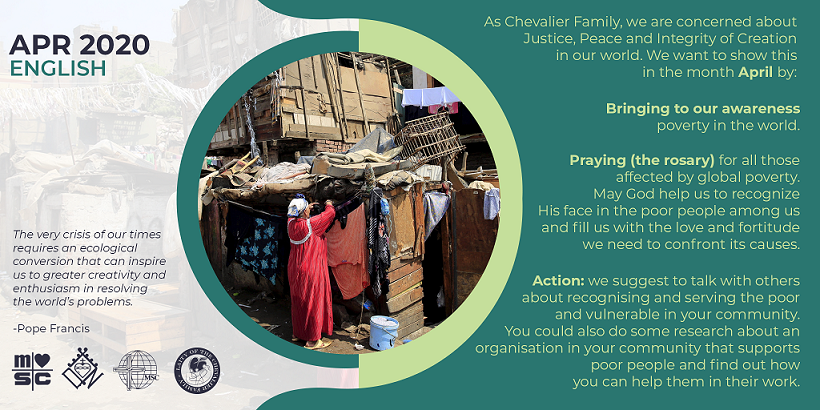 However, below the poster is a letter from our Cameroun confrere, Jonas Hassan Mouchi MSC, writing from the formation house in Congo.
However, below the poster is a letter from our Cameroun confrere, Jonas Hassan Mouchi MSC, writing from the formation house in Congo.
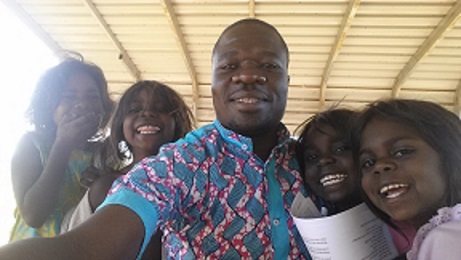
Jonas in the NT during his study time in Sydney 2017
We are probably not up to the minute with news from Africa. This First Friday, their intentions are our intentions.
Jonas writes: Glad to write you. Hope you are well despite the covid.19 pandemonia.
With more than 15millions inhabitants in Kinshasa, the government has taken some important decisions that will impact directly the daily life even if some are very unpopular.
As you in most of our African countries, populations have nothing to expect from the government. They have been forgotten for long time. So they have to face security forces in order to get their bread. And unfortunately the disease is spreading on.
It is a real dilemma in our country. The government has to choose between shutting down everything and face uprising and huge protests or leaving everything normal and face the spread of that disease.
We are locked down in the noviciate over these 2 last weeks and prepared to face weeks to come. Am just worried about the 30days retreat that is supposed to take place and the end of April.
We are waiting these days rain after a unbearable heat wave.
Greetings for all of you
KENSINGTON MONASTERY LOCKDOWN – BUT PHOTOS STILL ACCESSIBLE
KENSINGTON MONASTERY LOCKDOWN – BUT PHOTOS STILL ACCESSIBLE
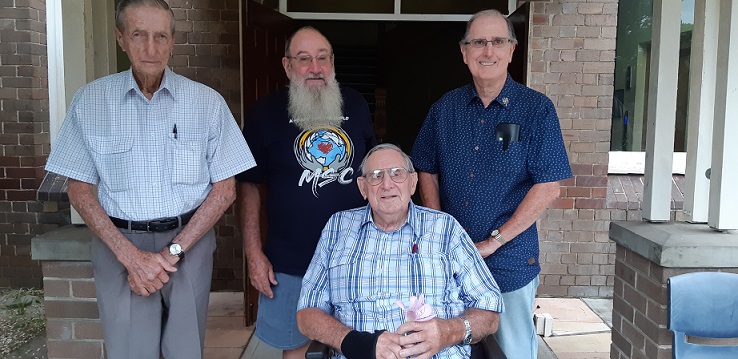
Back Row: Ted Merritt, Roger Purcell, John Kelliher. Front row: Herman Kooyman.
As noted on the site last week, Kensington is in lockdown. You won’t be able to visit for some time – and the community can’t visit you. However, community leader, John Kelliher MSC, kindly sent some photos of the visit of Herman Kooyman MSC last month. Photos are not in lockdown. You will recognise many of the faces.
More in coming weeks.
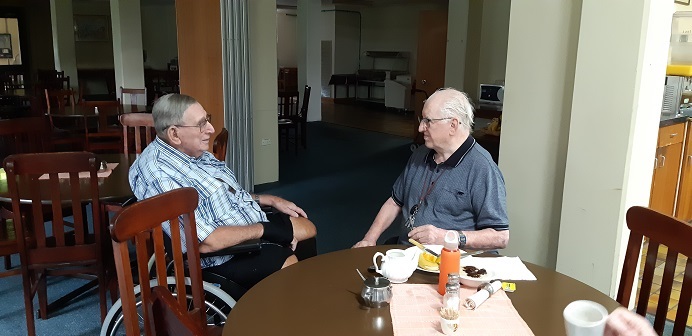
With Martin Wilson
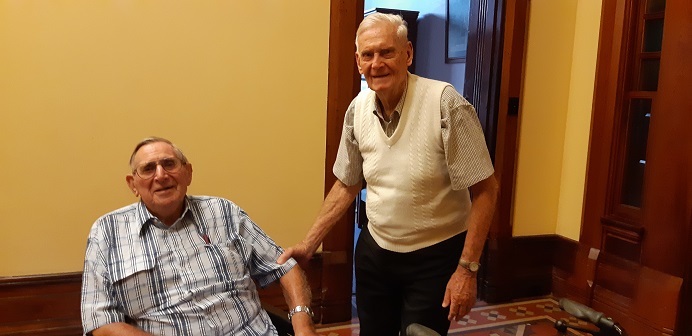
With Neville Dunne
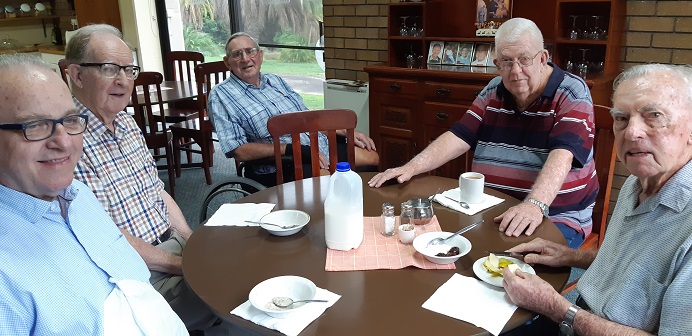
Left to right: Jac Boelen, Jim LIttleton, Herman, Paul Bowen, Neville Dunne.
SOME SIGNIFICANT APRIL DAYS FOR THE CHEVALIER FAMILY, 2020
SOME SIGNIFICANT APRIL DAYS FOR THE CHEVALIER FAMILY, 2020
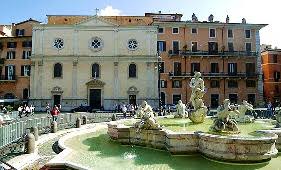
Some emphasis on buildings during this month – and mission outreach.
However…
In years to come, March-April, 2020, will be remembered as the months in which covid-19 moved to rapid expansion around the whole world.
We remember March already – and have received word that three of our MSC confreres in Spain have the virus, one in Belgium with another at the time of posting waiting results of tests.
3 April, 1857
First meeting of the "Oeuvre des Campagnes" ("Work of the Countryside") arranged by Father Vandel, held in the house of Madam de la Rochejaquelin. This was a social and spiritual outreach to diocesan priests working in isolated areas. This groups continues to the present day, and meets in Issoudun once a year.
5 April, 1925
Arrival of the first three MSC Sisters from Hiltrup, in Vunapope (PNG), after World War I.
6 April, 1864
Bishop de la Tour d'Auvergne (of Bourges) presents the Statutes of the Fraternity of Our Lady of the Sacred Heart in Issoudun and signs as first member. To make membership in the Fraternity possible for everyone,
Father Chevalier stipulates that the only requirement is to pray daily: "Our Lady of the Sacred Heart pray for us".
6 April, 1904
Death of the first Superior General of the MSC Sisters, Sister Servatia Rath, Congregation of the Sisters of Divine Providence.
7 April, 1872
Official installation of Father Chevalier as parish priest of St. Cyr parish, in Issoudun.
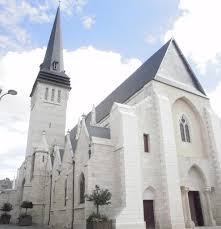
8 April, 1850
Jules Chevalier is ordained sub-deacon in the seminary chapel in Bourges. "On the very day of his ordination, he showed himself completely renewed, from silent and severe to affable and gentle." (Piperon)
9 April, 1866
Fathers Chevalier and Vandel planned the foundation of an "apostolic" school, which did officially open in Chezal-Benoît on 10 October the following year, about 17 kilometers from Issoudun.
This was an apostolic school for boys interested in becoming missionaries in the MSC's. In order to meet the cost of this work, an appeal was made to give a apenny a year - thus the name the "Petite Oeuvre" (the "Little Work").
11 April, 1868
The Chapel of Our Lady of the Sacred Heart is opened in Issoudun.
12 April, 2012
Feast of Saint Jules, (Pope Jules I, who protected Saint Athanasius from the Arians), name day of Father Founder.
16 April, 1881
Chevalier accepts the two Vicariates of Melanesia and Micronesia offered by the Congregation of the propagation of the Faith.
20 April, 1876
First mission departure ceremony in MSC history:
Father Durin and two scholastics are sent from Issoudun to Watertown, in New York State, USA. They arrive in Watertown on 6 May, 1876.
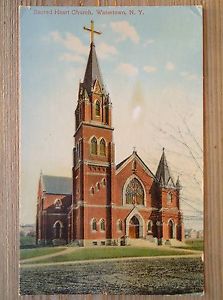
The previous General of the MSC's, Father Mark McDonald, was from Watertown!
24 April, 1879

Canonical erection of the first MSC House in Rome, at Piazza Navona.
26 April, 1877
Father Jean Marie Vandel, founder of the Apostolic Schools, dies in Issoudun. Chevalier said of him: "His life ... is that of a saint."
30 April, 1907
Sale by auction of the confiscated property of the MSC and FDNSC in Issoudun. Count de Bonneval buys the MSC property for 100,000 francs; ten minutes later Madame de Lapparent buys the house of the Sisters for 40,000. The property is thus saved for both the MSC and FDNSC.
REMEMBERING THE GREAT FLU AND OUR LADY’S NURSES
REMEMBERING THE GREAT FLU AND OUR LADY’S NURSES
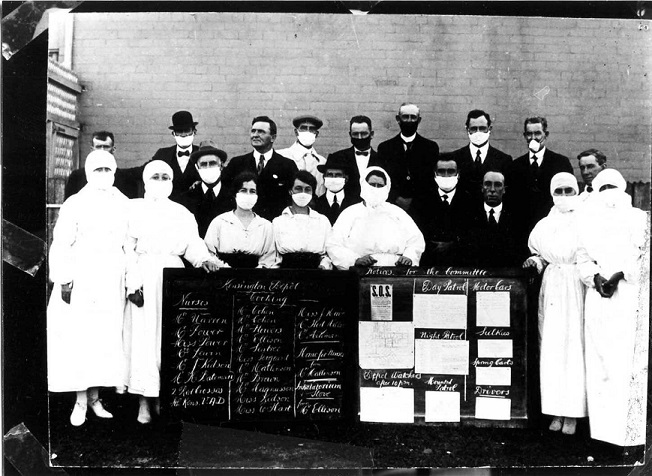
Masked influenza relief workers outside Blackfriar’s Depot, Chippendale, Sydney, 1919. Randwick City Library, local history collection.
Recalling the Great Flu of 1919 and the Heroism of Our Lady’s Nurses for the Poor
Mary O’Connell
In 1919 Australian soldiers returning from the War brought with them the virus of the ‘Spanish’ flu (also known as the Great Flu) which claimed at least 20 million lives around the world in the years 1918–19, and killed over 12,000 people in Australia, over half of these deaths occurring in NSW.[i]
What proved so fatal was not so much the bout of viral influenza, debilitating enough, but its secondary bacterial infection of pneumonia. People died rapidly and frighteningly with blood and sputum-choked respiratory systems.
The flu slaughtered young and active adults as much as it did influenza’s usual victims, the aged and young children. The poor, as usual, were particularly vulnerable. Undernourished and chronically stressed from overcrowding, financial anxiety and poor housing sanitation, they were at greater risk from this post-War pandemic.
Twenty-first century concerns have resurrected the Great Flu narrative but for decades it was a story obscured by the First World War. Its loss to cultural memory and a full place in the national story may have been due to the prevailing masculinist worldview. While defeat - such as Gallipoli -and wounds are legitimate sufferings of the hero, sickness is rarely if ever seen as heroic.
Yet the Influenza pandemic produced plentiful acts of heroism, including that of Our Lady’s Nurses for the Poor at Coogee (OLNP), founded in 1913 by young Irish Australians Eileen O’Connor (1892 -1921) and Edward McGrath, MSC. (1881 -1977)
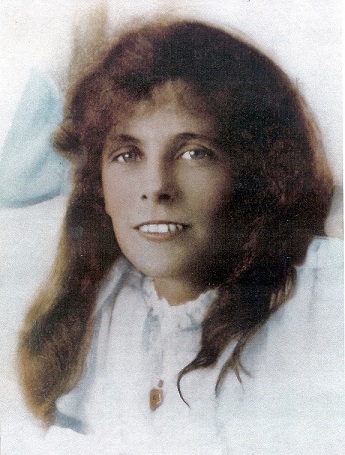
This grass roots (McGrath was a rookie priest, O’Connor a bed-ridden girl with a severe spinal disability) community had run into trouble with the clerical authorities within a few years of its founding. At the time of the Great Flu, the small group of nurses were living under very difficult financial and psychological circumstances – supported by their devout families and friends of the mystic O’Connor – but frozen out by ecclesiastical Sydney.
Considering the dangers of this flu, Eileen O’Connor had first sought the permission of the families of her nurses as to whether they could tend to influenza cases. When they had all agreed, the Home embarked on preparing gowns, caps and masks, while the Patrician Brothers of Holy Cross College sent their car from Ryde for sole use by the Nurses. Within two days the women were ready. Aided by at least two Marists, Brother Frank Malin and Fr Gilham, they worked non-stop for the first two weeks of April 1919 before five nurses, including Matron Sarah Hawkshaw, were struck down themselves with the flu.
Our Lady’s Nurses had then to quarantine themselves. Eileen rang or wrote to all their worried families almost daily. Only Sarah Hawkshaw did not recover; she died on 22 April 1919. Her death was a great blow to the community. Nurse Kit McGrath wrote in her journal that Matron had given her life in ‘helping to fight this dreadful disease. Our loss is indeed great and sadness and love fill our hearts and the hearts of many of our Poor. Where she will live until the end of our lives.’
When the other nurses got up from their sickbeds, Eileen, now acting as Matron, thought to give them all two months rest. But in June 1919 a second wave of the pandemic broke over Sydney, and they went out again to meet it. One nurse wrote home to her anxious family: ‘you could not do anything else only nurse it, when people are crying out for nurses and can’t get anyone.’

In June 1919 Eileen wrote: ’The call on nurses just now is very high. It is ten weeks since we went out at all but again we must go out, there is no help for it. I am to be kept at home as long as it can be arranged. I have no fear but only feel sad that I am kept back even a day from doing my duty.’
Good nursing care makes a difference to recovery from illness. OLNP made a difference to the story of the influenza pandemic in Sydney. The Nurses saved the lives of many elderly poor, and impoverished mothers and children, although for many other sufferers, the Nurses could only offer comfort or companionship as they died.
Eileen fought to keep their focus on nursing only the very poor, despite the new panicked demands of wealthier citizens also terrified by the pandemic. She answered all calls for help, but for those who could afford to pay Eileen organised outside nurses whom she knew and trusted, in effect running a nursing agency, a practice she would continue in less stressful times.
If they had been united by adversity before, the experience of the flu forged even deeper bonds between the nurses, and between them and their stalwart communities. It also eased some of the tensions between OLNP and their conservative Archbishop Michael Kelly.
The end of the pandemic saw the return of some form of respectability for OLNP, and a new respect for their heroic leader, the young woman now seen as Australia’s next saint-in-waiting, Eileen O’Connor.
With thanks to the Bulletin of Our Lady of the Sacred Heart Parish, Randwick, Tony McNamara and Debra Lawrence
Dr Mary O’Connell a writer and historian, has published a book, Our lady of Coogee on Eileen O’Connor and the founding of Our Lady’s Nurses for the Poor.
[i] Dr Gregory Haines, ‘The 1918 -19 ‘flu pandemic in Australia’, A History of the Pharmacy Board of New South Wales, http://www.science.org.au/nova/014/014print.htm [Downloaded 2 February 2004]
IN OUR ISOLATION, OPPORTUNITY TO LEARN MORE MSC STORIES FROM AROUND THE WORLD
IN OUR ISOLATION, OPPORTUNITY TO LEARN MORE MSC STORIES FROM AROUND THE WORLD.

THE BELOVED AMAZON
Report from Humberto Henriques MSC
Before we had to stop the accompaniments because of the restrictions of the covid-19 pandemic, I had the opportunity to travel to our MSC mission in Amazonas to get to know that reality and to suport the confreres there. We are there in a parish in the city of São Gabriel da Cachoeira composed of 7 communities in the city and 18 communities called "ribeirinhas". The latter are in fact indigenous villages on the banks of two rivers: Rio Negro and Rio Uapés.
To reach this city with a little more than 30.000 inhabitants, we have three options: a small plane (that makes the route in almost 2 hours); a médium boat (that takes about 3 days); or an express boat (that makes the route in about 30 hours) from Manaus, the capital of Amazonas´ State to São Gabriel da Cachoeira. There are currently two MSC´s confreres at the head of the mission (Ivo and José Marcos) and for this year they are expecting one more to help in this important and arduous task of making the Heart of Jesus loved everywhere.
The Amazon has become for the Church a "locus theologicus", that is, a privileged place where God speaks to us through nature and the people who live there. The Pope begins the final document of the Synod by saying: "THE BELOVED AMAZON presents itself in the eyes of the world with all its splendor, its drama and its mystery. "(Querida Amazonia, n.1). And then, in number 7, he reveals four dreams for the Amazon:
A social dream: “I dream of an Amazon region that fights for the rights of the poor, the original peoples and the least of our brothers and sisters, where their voices can be heard and their dignity advanced.”- A cultural dream: “I dream of an Amazon region that can preserve its distinctive cultural riches, where the beauty of our humanity shines forth in so many varied ways. ”
- An ecological dream: “I dream of an Amazon region that can jealously preserve its overwhelming natural beauty and the super-abundant life teeming in its rivers and forests. ”
- And an ecclesial dream: “I dream of Christian communities capable of generous commitment, incarnate in the Amazon region, and giving the Church new faces with Amazonian features.”
The experience of being in contact with one of the largest rivers in the world, with an immense forest and with some indigenous peoples is a mystical experience. Taken by the splendour of the work created by God, we are called to look at life in its most varied forms and respect the diversity of cultures of each people.
Asked how they feel they live our charism there, our confreres affectionately answer: "We make a difference here. The people here tell us that we speak their language and they understand us by heart. Even because of the inculturated celebrations we celebrate, using their original language and the most important symbols for each indigenous person".
The diversity of our mission and the peoples to whom we are sent leads us to unify everything in one heart: the Heart of Jesus. "Everything is interconnected". Our mission is interdependent around the world. May the mission in the Amazon lands encourage us wherever we are, especially in moments of crisis like this moment of pandemic and uncertainty. We believe, as our founder did, that the remedy is there in the Heart of the Son of God. Let us dive into the deep waters of the river of love that flows from His Heart.
LAUGHTER, THE BEST MEDICINE? BUT IT CAN HELP.
LAUGHTER, THE BEST MEDICINE? BUT IT CAN HELP.

In these difficult, sometimes distressing times, some humour can offer some light relief.

These cartoons have been circulating and you may have seen them. More later, in weeks to come...

a tip for successfully working from home.

Lockdown challenge

AND.... IF ONLY...

BEST WISHES TO THE MSC SISTERS WORLDWIDE, 120 YEARS
BEST WISHES TO THE MSC SISTERS WORLDWIDE, 120 YEARS
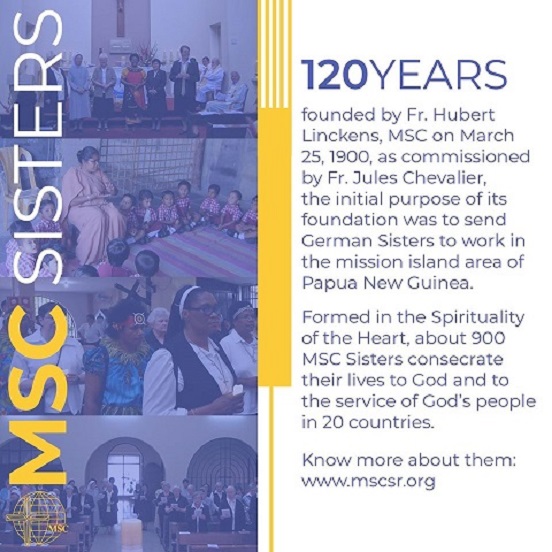
On March 25th, the MSC Sisters celebrate the anniversary of their foundation, their founder Hubert Linckens MSC, the spirit of Jules Chevalier MSC.
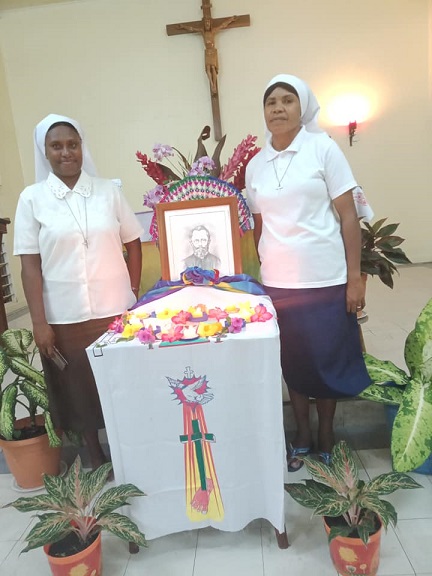
Below some pictures of the PNG Sisters celebration, with thanks to Rosemary Lavarabin and her Facebook page.
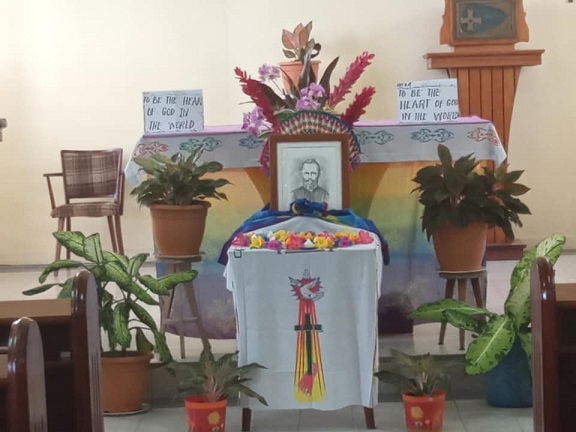
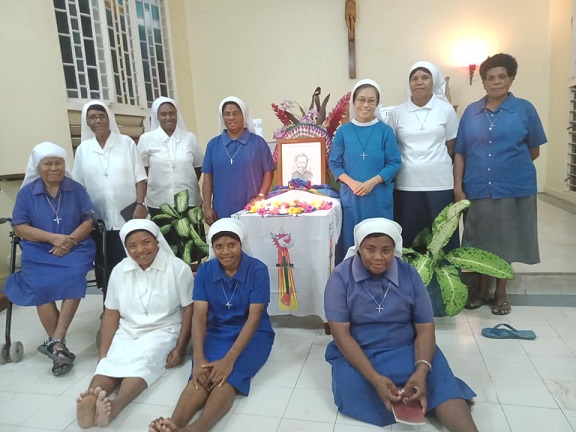
Update on Sacred Heart Monastery and St Mary’s Towers, Douglas Park , Lockdown
Update on Sacred Heart Monastery and St Mary’s Towers, Douglas Park, Lockdown
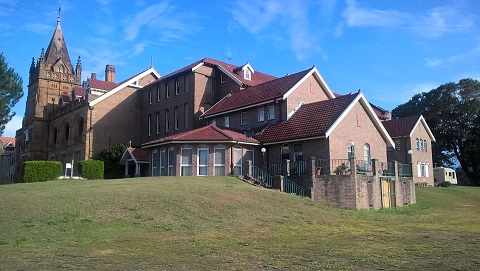
Letter from Provincial, Chris McPhee.
St Vincent’s Care Services and the MSC Aged Care Committee have directed that as of midnight tonight, Sacred Heart Monastery and St Mary’s Towers, Douglas Park are to be in Lockdown. This directive excludes Chevalier Resource Centre at this stage.

This means:
- · No visitors except aged care staff, contractors, or health care professionals
- · Residents appointments are for critical, clinical care and support by medical, pharmaceutical or health-related professionals only
- · A resident can now only leave the facility for health and medical reasons
- · All people who come onsite must have an up to date vaccination against influenza
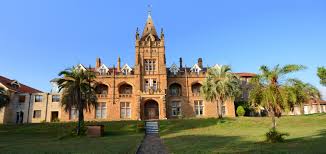
I wish to thank the Aged Care Committee, and St Vincent’s Care Services for their ongoing advice concerning this most difficult period in our history.
I would like to sincerely thank Fr John Kelliher MSC and Fr Dominic Gleeson MSC for their implementation of this present lockdown and for making certain this lockdown will be effective in protecting our men.
Above all, my personal thanks to each and every one of you my brothers, who are residing in Sacred Heart Monastery and St Mary’s Towers, for your understanding and cooperation in keeping yourself and members of our community safe.